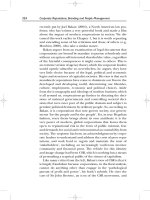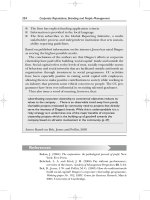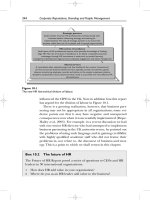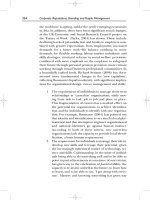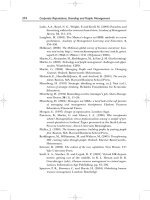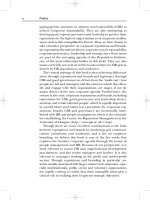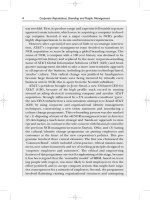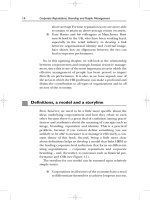Corporate Reputations, Branding and People Management 39
Bạn đang xem bản rút gọn của tài liệu. Xem và tải ngay bản đầy đủ của tài liệu tại đây (127.31 KB, 10 trang )
moreover it is increasingly inappropriate to discuss leadership
purely in terms of organizational boundaries, which are ever
more irrelevant in modern networked forms. Leadership, like
strategy, has to leverage value from people in organizations
over which it has no direct authority.
The well-rounded HR leader
The need for craftsmanship as well as
potential
So what does a well-rounded HR leader look like? The first point
to reflect on is the dangers pointed out by Sennett (2006) in
over-valuing potential and the ‘learning how to learn’ model, and
in under-valuing craftsmanship, expertise and experience. This
warning is especially relevant in the context of the new hier-
archy of HR professionalism and the emerging division of labour
between strategic partners and centres of excellence, both of
which reflect trends in the ‘cutting-edge’ firms of Sennett’s new
capitalism and help embed these trends in society. As he points
out in the book, the basis on which esteem in society is accorded
to individuals has been based on merit and expertise; ask most
people in developed economies who they would hold in high
esteem, as many international surveys have done, and you
are likely to get the answer doctors, nurses, teachers, engineers,
social workers, and even lawyers, academics and entrepreneurs
in certain country rankings of occupational prestige. Such surveys
will also include skilled manual crafts, but, interestingly, rarely
include managers in the top echelons of the rankings. The rea-
sons for this are that people are valued for abilities developed
within themselves, for their craftsmanship. This notion of crafts-
manship evokes a world where a job well done in its own right,
a concern for standards and expertise, and knowing something
well is valued above all else.
In ‘liquid modern’ societies, however, there is little that is
stable about work, talent and consumption; transactions have
replaced relationships in people’s dealings with one another.
The new institutional architecture, according to Sennett, more
364 Corporate Reputations, Branding and People Management
closely resembles the infinitely flexible architecture of the MP3
player than the classic bureaucratic pyramid; thus it is potential
that counts. So ‘cutting-edge firms and flexible organizations
need people who can learn new skills rather than cling to old
competencies … human “potential” consists in how capable he
or she is in moving from problem to problem, subject to sub-
ject’ (Sennett, 2006, p. 115). Perhaps the classic metaphor for
such potential is the management consultant who flits from job
to job, organization to organization and industry to industry
without having a deep understanding of any single location,
problem or body of expertise. In fact, the idea of skill and expert-
ise is often an anathema to consultants who are frequently taken
on to ‘re-engineer’ organizations that embody craftsmanship and
creativity. He cites UK research on the use of young MBA-trained,
McKinsey consultants at the British Broadcasting Corporation
(BBC), who tended to devalue creative work because they did
not understand it, were paid to re-engineer the organization by
reducing the number of creative people, and then left it in tur-
moil after a quick departure.
One of the main lessons from Sennett for this book is that
potential is a damaging measure of talent, and we are inclined
to agree; witness the emphasis placed on such young talent at
Enron. The decline of craftsmanship in cutting edge organiza-
tions, he contends, leaves three ‘social deficits’. The first is low
organizational loyalty or potential for organizational identifi-
cation. As Baumann (2000) argues, identification is a naturally
occurring and local phenomenon born out of being valued
and in valuing the ‘local’, not something which is planned or
forced on people by (corporate) identity engineers. And loy-
alty for most organizations is essential during business cycles
when the going gets tough, or when labour markets encourage
frequent moves among talented people. The second social deficit
is trust, which we discussed in an earlier chapter. Ever more fre-
quent change in business cycles and re-engineering through
change programmes diminishes informal trust among employ-
ees, but at the same time, makes trust more essential to cope
with such circumstances. The third deficit, and perhaps the
most important point for our discussion of the future of HR
professionals, is the requirement for institutional or organiza-
tional knowledge. What is required in many large, bureaucratic
Chapter 10 Creating a fit-for-purpose future 365
organizations is knowledge of how to make the system work,
which, according to Sennett, has developed into an art form in
learning ‘how to oil the bureaucratic wheels’ (2006, p. 69). Yet
such people are often low in the pyramid, frequently let go or
outsourced, or subject to replacement from a talent manage-
ment system that privileges the outsider over the insider. But
organizational knowledge – both inside and among the increas-
ing external relationships on which organizations depend for
survival – is also a feature of craftsmanship. Skilled accom-
plishment is as much a function of internal and close external
networks as it is of inherent skill. Karl Weick (2001) describes
how effective managers need to be good ‘bricoleurs’ – to be
able to fashion innovative solutions from an intimate knowledge
of the materials they have to hand – which is highly dependent on
in-depth organizational knowledge and their internal and
external networks.
All three social deficits are being accelerated by the new ver-
sion of talent and the premium placed on potential, and the
narrow idea of professionalization. We fear that the Ulrich HR
architecture may be a product of such thinking, at least as it has
been interpreted by many organizations, and perhaps part of
the problem rather than the solution. Instead, we propose a
more balanced view of HR professionalism and leadership,
based on the work of people such as Mintzberg, Weick and
others. In a recent book by one of us, there was an attempt to
construct a model of a well-rounded manager, which is particu-
larly apposite to the present discussion of HR leadership and
the corporate agenda (Martin, 2006).
The need to manage at different levels
To be effective, we believe that HR leaders have to translate their
personal qualities or competencies into the kinds of effective
behaviours needed inside, across and outside of their organiza-
tions. According to Mintzberg (1994), well-rounded managers
demonstrate these behavioural competences at three levels, mov-
ing outwards from the conceptual level to the doing or action
level. So, good HR leaders need not only to conceptualize, plan
366 Corporate Reputations, Branding and People Management
and manage on the outside and from on high, as the Ulrich
model is often taken to imply, but also to:
■ manage action, by doing things directly themselves
■ manage people, to get things done through others, and
■ manage information, to influence people to take
action.
As Mintzberg pointed out, leaders and managers can choose
to focus on any of these levels but action taken at one of them
has ‘knock-on’ consequences for action taken at other levels.
HR leaders will also be stylized by the level at which they pre-
fer to work and, most importantly, by how other, often sceptical,
managers and employees see them working. Thus, some leaders
who favour a more ‘hands-off’ style prefer to work at the infor-
mational level; ‘people-oriented’ HR leaders will prefer to work
through others, namely line managers and HR staff; whilst ‘doers’,
often in more front line roles or who wish to take a direct lead by
‘rolling up their sleeves’, will take direct action. The main point
of this discussion is that though the Ulrich model suggests a bal-
ance among such levels, current interpretations of the model
by many organizations and the new hierarchy in HR implies no
such balance.
Furthermore, the idea of a balance itself is a rather problem-
atic concept. In his most recent work on management, Mintzberg
(2004) has reworked these issues of preferences in managerial
styles and levels into a model of three poles of managing that
touch on our earlier discussions of narrow HR professionalism
and the need for craftsmanship as well as potential. This model
is highly relevant to our desire to link HR leadership to the
corporate agenda and tackles the notion of balance head-on.
Mintzberg depicts management (note that he has a problem
with the idea of leadership as somehow distinct from manage-
ment, and so do we) as a science, as vision and as a craft (see
Figure 10.3).
Translating his ideas into an HR context, there will be those
HR leaders who prefer to work at the informational level, typic-
ally framing their roles in terms of management as a science,
which involves applying rational techniques and thinking
about leadership and strategy best achieved through systematic
assessment and planning. There will also be HR leaders and
Chapter 10 Creating a fit-for-purpose future 367
managers who prefer to work through people, who are more
likely to be influenced by the idea of management as an art,
which relies on creative insights and holding out a novel and
compelling vision that others can buy into. Finally, there will be
those HR leaders and managers who prefer to work by taking
direct action, typically influenced by the notion that manage-
ment as a craft, learned and practised through direct experi-
ence, experimentation and doing.
The critical point, according to Mintzberg, is that the well-
rounded manager (for our purposes, read HR leader) needs to
function effectively at all three levels and achieve balance among
all three poles in Figure 10.3, a message also mirrored by the
368 Corporate Reputations, Branding and People Management
HR leadership as
art
(the ‘vision’ thing
and build
potential)
HR leadership as
science
(analysis and
strategic thinking)
HR leadership as
a craft
(experience and
doing things well)
Calculating style Tedious style
Narcissistic style
Problem-solving style
Engaging
style
Visionary
style
Heroic
style
Too
balanced?
Figure 10.3
HR leadership styles (based on Mintzberg, 2004 and Sennett, 2006).
